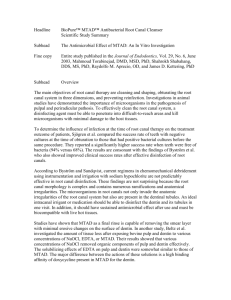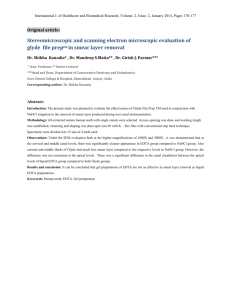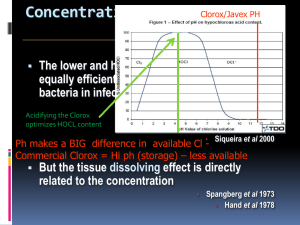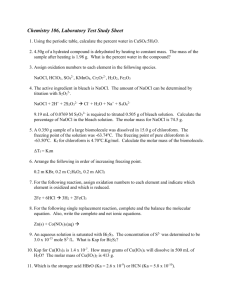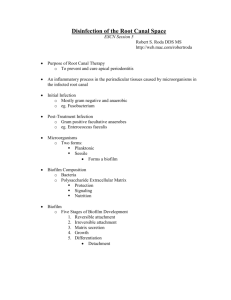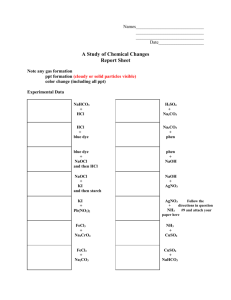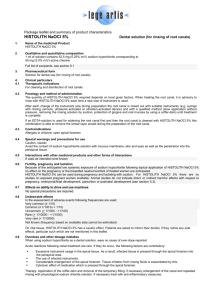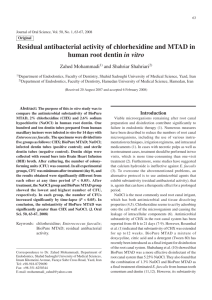A Comparison of the Antimicrobial Efficacy of NaOCl/ Biopure MTAD
advertisement
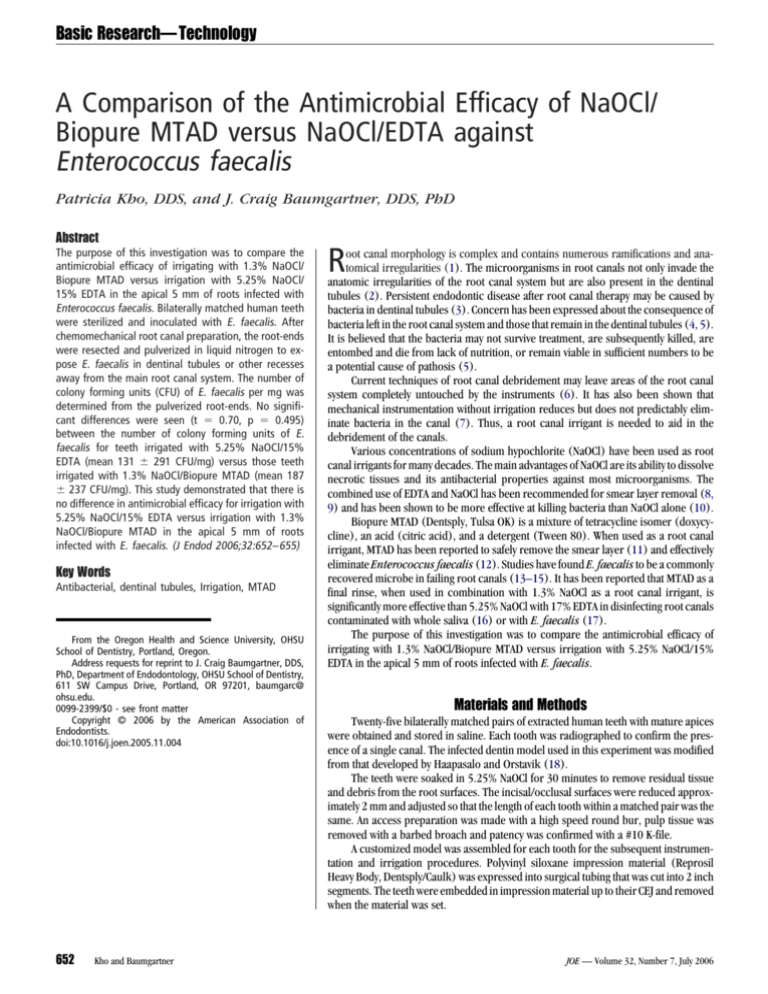
Basic Research—Technology A Comparison of the Antimicrobial Efficacy of NaOCl/ Biopure MTAD versus NaOCl/EDTA against Enterococcus faecalis Patricia Kho, DDS, and J. Craig Baumgartner, DDS, PhD Abstract The purpose of this investigation was to compare the antimicrobial efficacy of irrigating with 1.3% NaOCl/ Biopure MTAD versus irrigation with 5.25% NaOCl/ 15% EDTA in the apical 5 mm of roots infected with Enterococcus faecalis. Bilaterally matched human teeth were sterilized and inoculated with E. faecalis. After chemomechanical root canal preparation, the root-ends were resected and pulverized in liquid nitrogen to expose E. faecalis in dentinal tubules or other recesses away from the main root canal system. The number of colony forming units (CFU) of E. faecalis per mg was determined from the pulverized root-ends. No significant differences were seen (t ⫽ 0.70, p ⫽ 0.495) between the number of colony forming units of E. faecalis for teeth irrigated with 5.25% NaOCl/15% EDTA (mean 131 ⫾ 291 CFU/mg) versus those teeth irrigated with 1.3% NaOCl/Biopure MTAD (mean 187 ⫾ 237 CFU/mg). This study demonstrated that there is no difference in antimicrobial efficacy for irrigation with 5.25% NaOCl/15% EDTA versus irrigation with 1.3% NaOCl/Biopure MTAD in the apical 5 mm of roots infected with E. faecalis. (J Endod 2006;32:652– 655) Key Words Antibacterial, dentinal tubules, Irrigation, MTAD From the Oregon Health and Science University, OHSU School of Dentistry, Portland, Oregon. Address requests for reprint to J. Craig Baumgartner, DDS, PhD, Department of Endodontology, OHSU School of Dentistry, 611 SW Campus Drive, Portland, OR 97201, baumgarc@ ohsu.edu. 0099-2399/$0 - see front matter Copyright © 2006 by the American Association of Endodontists. doi:10.1016/j.joen.2005.11.004 652 Kho and Baumgartner R oot canal morphology is complex and contains numerous ramifications and anatomical irregularities (1). The microorganisms in root canals not only invade the anatomic irregularities of the root canal system but are also present in the dentinal tubules (2). Persistent endodontic disease after root canal therapy may be caused by bacteria in dentinal tubules (3). Concern has been expressed about the consequence of bacteria left in the root canal system and those that remain in the dentinal tubules (4, 5). It is believed that the bacteria may not survive treatment, are subsequently killed, are entombed and die from lack of nutrition, or remain viable in sufficient numbers to be a potential cause of pathosis (5). Current techniques of root canal debridement may leave areas of the root canal system completely untouched by the instruments (6). It has also been shown that mechanical instrumentation without irrigation reduces but does not predictably eliminate bacteria in the canal (7). Thus, a root canal irrigant is needed to aid in the debridement of the canals. Various concentrations of sodium hypochlorite (NaOCl) have been used as root canal irrigants for many decades. The main advantages of NaOCl are its ability to dissolve necrotic tissues and its antibacterial properties against most microorganisms. The combined use of EDTA and NaOCl has been recommended for smear layer removal (8, 9) and has been shown to be more effective at killing bacteria than NaOCl alone (10). Biopure MTAD (Dentsply, Tulsa OK) is a mixture of tetracycline isomer (doxycycline), an acid (citric acid), and a detergent (Tween 80). When used as a root canal irrigant, MTAD has been reported to safely remove the smear layer (11) and effectively eliminate Enterococcus faecalis (12). Studies have found E. faecalis to be a commonly recovered microbe in failing root canals (13–15). It has been reported that MTAD as a final rinse, when used in combination with 1.3% NaOCl as a root canal irrigant, is significantly more effective than 5.25% NaOCl with 17% EDTA in disinfecting root canals contaminated with whole saliva (16) or with E. faecalis (17). The purpose of this investigation was to compare the antimicrobial efficacy of irrigating with 1.3% NaOCl/Biopure MTAD versus irrigation with 5.25% NaOCl/15% EDTA in the apical 5 mm of roots infected with E. faecalis. Materials and Methods Twenty-five bilaterally matched pairs of extracted human teeth with mature apices were obtained and stored in saline. Each tooth was radiographed to confirm the presence of a single canal. The infected dentin model used in this experiment was modified from that developed by Haapasalo and Orstavik (18). The teeth were soaked in 5.25% NaOCl for 30 minutes to remove residual tissue and debris from the root surfaces. The incisal/occlusal surfaces were reduced approximately 2 mm and adjusted so that the length of each tooth within a matched pair was the same. An access preparation was made with a high speed round bur, pulp tissue was removed with a barbed broach and patency was confirmed with a #10 K-file. A customized model was assembled for each tooth for the subsequent instrumentation and irrigation procedures. Polyvinyl siloxane impression material (Reprosil Heavy Body, Dentsply/Caulk) was expressed into surgical tubing that was cut into 2 inch segments. The teeth were embedded in impression material up to their CEJ and removed when the material was set. JOE — Volume 32, Number 7, July 2006 Basic Research—Technology 25 Sterile Matched Pairs n=50 Negative Controls n=4 Positive Controls n=6 Experimental Group n=40 E. faecalis inoculation and incubation 4 weeks Surface disinfection 1 min 5.25% NaOCl 1 min 5% Na2S2O3 Surface disinfection 1 min 5.25% NaOCl 1 min 5% Na2S2O3 Instrumentation & Irrigation Saline n=6 Instrumentation & Irrigation 5.25% NaOCl 15% EDTA/5.25% NaOCl n=20 Instrumentation & Irrigation 1.3% NaOCl Biopure MTAD n=20 Resect apical 5 mm Pulverize in liquid nitrogen Weigh samples Culture serial dilutions Incubate 48 h Enumerate CFU Figure 1. Flowchart of the methodology. The teeth, customized models and 20 ml scintillation vials were separately steam autoclaved at 121°C for 30 minutes. Each tooth was individually placed into a sterile scintillation vial, and 5 ml of sterile Brain Heart Infusion (BHI) broth was added. The samples were incubated in their sealed vials for 48 hours at 37°C and inspected daily to ensure that the BHI broth showed no signs of turbidity. Five matched pairs of teeth were randomly selected as controls. These were further divided into two negative control pairs and three positive control pairs. Negative control teeth were cultured to ascertain the effectiveness of the sterilization procedures. The methodology for each group is summarized in Fig. 1. An inoculum of a 24 hours pure culture suspension of E. faecalis (ATCC 19433) grown in BHI broth was prepared. The 20 experimental and the three positive controls pairs were inoculated with E. faecalis and cultured for 4 weeks under aerobic conditions at 37°C. The media was replenished every 7 days. When replacing intracanal media, random samples from the root canals were cultured to confirm growth of E. faecalis. Colonies of E. faecalis in pure culture were detected as white pinpoint colonies on the agar media that microscopically consisted of gram-positive cocci arranged in a cross-chain pattern. Before working length determination, the surfaces of the experimental and positive control teeth were disinfected by immersion in 5.25% NaOCl for 1 minute followed by inactivation of the NaOCl with sodium thiosulphate. Efficacy of the surface disinfection was tested by sampling the root surface with paper points. The paper points were placed into a test tube containing 1 ml reduced transport fluid, vortexed for 10 seconds, plated onto BHI agar, incubated at 37°C for 48 hours and examined for growth. Teeth were randomly assigned to either group A or group B within each experimental pair. To establish working length, a #10 K-file was inserted into each root canal until it appeared at the minor diameter under 10⫻ magnification. With the file in place, the apical foramen was sealed with cyanoacrylate (Super Glue Corporation, Rancho Cucamonga, CA) and each tooth was placed into their respective sterile JOE — Volume 32, Number 7, July 2006 customized models for instrumentation. A coronal seal between the tooth and the model was achieved with cyanoacrylate. Both teeth within each matched pair were instrumented to the same master apical file size and the same volume of irrigants was used during the instrumentation process. The instrumentation sequence for both teeth within each matched pair was the same except for the irrigation regimen. Coronal flaring was accomplished using size 2-4 Gates Glidden drills. The canals were prepared to working length in a crown-down manner using ProFile Series 29 .04 taper rotary files (Dentsply, Tulsa OK). The master apical file size was a ProFile Series 29 #6 file (ISO .360). Irrigation of the root canals was completed as follows. Group A During chemomechanical root canal preparation, each file was followed by irrigation with 1 ml of 5.25% NaOCl. Irrigation was accomplished using a 30 gauge ProRinse needle (Dentsply) placed 1 to 2 mm short of the working length. Final irrigation was completed by using 5 ml of 15% EDTA followed by 5 ml of 5.25% NaOCl. The total irrigation time for the final irrigation sequence was 2 minutes. The canals were then dried with sterile paper points. Group B During chemomechanical root canal preparation, each file was followed by irrigation with 1 ml of 1.3% NaOCl. Irrigation was accomplished using a 30 gauge ProRinse needle placed 1 to 2 mm short of the working length. Biopure MTAD was prepared and utilized according to the manufacturer’s instructions. One millimeter Biopure MTAD was placed into the canal for 5 minutes. This was followed by a 4 ml irrigation of the canals with Biopure MTAD. The canals were then dried with sterile paper points. The positive control teeth were instrumented as described earlier except teeth were irrigated with 1 ml saline after each instrument. The Comparison of Antimicrobial Efficacy 653 Basic Research—Technology TABLE 1. Mean CFU/mg Irrigation Mean CFU/mg SD 5.25% NaOCl/15% EDTA 1.3% NaOCl/Biopure MTAD Saline 1.31 ⫻ 10 1.87 ⫻ 102 3.77 ⫻ 102 2.91 ⫻ 102 2.37 ⫻ 102 3.02 ⫻ 102 2 No significant differences between all groups. final irrigation of the canals was accomplished with 5 ml of saline. The canals were then dried with sterile paper points. To test for bacterial survival in the apical 5 mm of the root canal system and dentinal tubules, sterile multipurpose burs in a rear exhaust surgical handpiece (Impact Air 45, Palisades Dental, NJ) were used to resect the apical 5 mm of all experimental and positive control teeth. The samples were pulverized for 30 seconds in liquid nitrogen using a sterile mortar and pestle. The crushed samples were collected and weighed on sterile aluminum foil. The samples were then suspended in 1 ml of reduced transport fluid. Ten-fold dilutions were prepared and 0.1 ml aliquots of the suspensions were spread onto BHI agar media. They were incubated at 37°C for 48 hours and the colony forming units (CFU) enumerated. Using the weight of the pulverized root-end, the number of CFU/mg was determined. Specimens from the control pairs were sampled and cultured using the same techniques. The purity of the positive cultures was also confirmed. A repeated measures t test was used to determine if there was a significant difference in CFU/mg between groups A and B. Independent t tests were used to compare group A to the positive controls and group B to the positive controls. Results The results are summarized in Table 1. Mean CFU/mg for group A was 131 ⫾ 291 and 187 ⫾ 237 for group B. The mean CFU/mg for the positive control group was 377 ⫾ 301. No significant differences were found between groups A and B (t ⫽ 0.70, p ⫽ 0.495). Independent t tests also showed no significant differences between group A versus the positive controls (t ⫽ 1.80, p ⫽ 0.0857) and no significant differences between group B and the positive controls (t ⫽ 1.61, p ⫽ 0.121). Negative control teeth showed no growth throughout the experiment. No bacterial growth was seen from the root surface samples that had been disinfected with 5.25% NaOCl. Discussion Three weeks incubation of root canals inoculated with E. faecalis has been shown to produce a dense infection reaching 300 to 400 m into the dentinal tubules (18). Prolonged incubation leads to more tubules being infected, whereas the average depth of penetration of the tubules by bacteria has been found to increase only slowly with time (18). Pulverizing teeth for bacterial sampling has been previously used (18, 20). Baker et al. (20) used liquid nitrogen to freeze bovine teeth and then pulverized them for evaluation of the antibacterial action of medicaments. By crushing teeth with a mortar and pestle, it is possible to determine CFU in dentinal tubules and other morphological recesses in addition to the main root canal system. Bacteriological sampling with paper points is limited because only the microorganisms collected on the paper points can be cultivated. Previous studies on the antimicrobial efficacy of MTAD have shown conflicting results. Shabahang and Torabinejad (17) found the combination of 1.3% NaOCl as a root canal irrigant with MTAD as a final rinse was more effective against E. faecalis than 5.25% NaOCl with 17% EDTA. However, Dunavant et al. (21) who compared the efficacy of 654 Kho and Baumgartner irrigants against E. faecalis biofilms in vitro, found 6% and 1% NaOCl were significantly more efficient in eliminating E. faecalis biofilms than Smear Clear, REDTA, and Biopure MTAD. A study by Johal et al. (22) found no growth of E. faecalis in root canals irrigated with 5.25% NaOCl/15% EDTA, while 50% of the canals irrigated with 1.3% NaOCl/ Biopure MTAD demonstrated growth of E. faecalis. The difference was statistically significant. Although an irrigant can penetrate into the dentinal tubules, it does not mean that the concentration is sufficient to kill all types of bacteria present (23). It has been previously shown that bacteria may remain viable in tubules at great distances from the pulp (24). This study and previous ones (25) have shown that disinfection of root dentin is not achieved by chemomechanical preparation alone. Bacteria deep in dentinal tubules are apparently protected from instrumentation and irrigation, making their removal or eradication difficult. Microorganisms may be eliminated or rendered harmless by entombing them through complete obturation of the canal space after chemomechanical root canal preparation (14). Although the consequences of microbes remaining in the dentinal tubules after root canal treatment is not clear (5), the main goal of root canal treatment is still the elimination of microorganisms. The efficacy of other irrigants and more effective irrigant delivery systems needs further research. In conclusion, the results of this study showed no significant differences in the antimicrobial efficacy of irrigating with 1.3% NaOCl/ Biopure MTAD versus irrigation with 5.25% NaOCl/15% EDTA in the apical 5 mm of roots infected with E. faecalis. The efficacy of saline irrigation was also not statistically different than the experimental irrigation groups. References 1. Vertucci FJ. Root canal anatomy of the human permanent teeth. Oral Surg Oral Med Oral Pathol 1984;58:589 –99. 2. Torabinejad M, Handysides R, Khademi A, Bakland LK. Clinical implications of the smear layer in endodontics: a review. Oral Surg Oral Med Oral Pathol Oral Radiol Endod 2002;94:658 – 66. 3. Haapasalo M, Orstavik D. In vitro infection and disinfection of dentinal tubules. J Dent Res 1987;66:1375–9. 4. Love MR. Clinical management of infected root canal dentin. PP&A 1998;8:581– 4. 5. Peters LB, Wesselink PR, Moorer WR. The fate and role of bacteria left in root dentinal tubules. Int Endod J 1995;28:95–9. 6. Davis SR, Brayton SM, Goldman M. The morphology of the prepared root canal: a study utilizing injectable silicone. Oral Surg Oral Med Oral Pathol 1972;34:642– 8. 7. Bystrom A, Sundqvist G. Bacteriologic evaluation of the efficacy of mechanical root canal instrumentation in endodontic therapy. Scand J Dent Res 1981;89:321– 8. 8. Yamada RS, Armas A, Goldman M, Lin PS. A scanning electron microscopic comparison of a high volume final flush with several irrigating solutions: part 3. J Endod 1983;9:137–142. 9. Baumgartner JC, Mader CL. A scanning electron microscopic evaluation of four root canal irrigation regimens. J Endod 1987;13:147–57. 10. Bystrom A, Sundqvist G. The antibacterial action of sodium hypochlorite and EDTA in 60 cases of endodontic therapy. Int Endod J 1985;1:35– 40. 11. Torabinejad M, Khademi AA, Babagoli J, et al. A new solution for the removal of the smear layer. J Endod 2003;29:170 –5. 12. Torabinejad M, Shabahang S, Aprecio RM, Kettering JD. The antimicrobial effect of MTAD: an in vitro investigation. J Endod 2003;29:400 –3. 13. Molander A, Reit C, Dahlen G, Kvist T. Microbiological status of root-filled teeth with apical periodontitis. Int Endod J 1998;31:1–7. 14. Sundqvist G, Figdor D, Persson S, Sjogren U. Microbiologic analysis of teeth with failed endodontic treatment and the outcome of conservative re-treatment. Oral Surg Oral Med Oral Pathol Oral Radiol Endod 1998;85:86 –93. 15. Hancock HH, Sigurdsson A, Trope M, Moiseiwitsch J. Bacteria isolated after unsuccessful endodontic treatment in a North Am population. Oral Surg Oral Med Oral Pathol Oral Radiol Endod 2001;91:579 – 86. 16. Shabahang S, Pouresmail M, Torabinejad M. In vitro antimicrobial efficacy of MTAD and sodium hypochlorite. J Endod 2003;29:450 –2. 17. Shabahang S, Torabinejad M. Effect of MTAD on Enterococcus faecalis-contaminated root canals of extracted human teeth. J Endod 2003;29:576 –9. JOE — Volume 32, Number 7, July 2006 Basic Research—Technology 18. Haapasalo M, Orstavik D. In vitro infection and disinfection of dentinal tubules. J Dent Res 1987;66:1375–9. 19. Akpata ES. Total viable count of microorganisms in the infected dental pulp. J Dent Res 1974;53:1330 –3. 20. Baker NE, Liewehr FR, Buxton TB, Joyce AP. Antibacterial efficacy of calcium hydroxide, iodine potassium iodide, Betadine, and Betadine scrub with and without surfactant against E. faecalis in vitro Oral Surg Oral Med Oral Pathol Oral Radiol Endod 2004;98:359 – 64. 21. Dunavant TR, Regan JD, Glickman GN, Soloman ES, Honeyman AL. Comparative evaluation of endodontic irrigants against E. faecalis biofilm. (Abstract) J Endod 2005;31:218. JOE — Volume 32, Number 7, July 2006 22. Johal S, Baumgartner JC, Marshall JG. Comparison of the antimicrobial efficacy of 1.3%NaOCl/Biopure MTAD to 5.25% NaOCl/15% EDTA for root canal irrigation. Accepted for publication, J Endod. 23. Buck R, Eleazer PD, Staat RH. In vitro disinfection of dentinal tubules by various endodontic irrigants. J Endod 1999;25:786 – 8. 24. Buck R, Eleazer PD, Staat RH, Scheetz JP. Effectiveness of three endodontic irrigants at various tubular depths in human dentin. J Endod 2001;27:206 – 8. 25. Siqueira JF, Araujo MCP, Garcia PF, Fraga RC, Saboia Dantas CJ. Histological evaluation of the effectiveness of five instrumentation techniques for cleaning the apical third of root canals. J Endod 1997;23:499 –502. Comparison of Antimicrobial Efficacy 655
